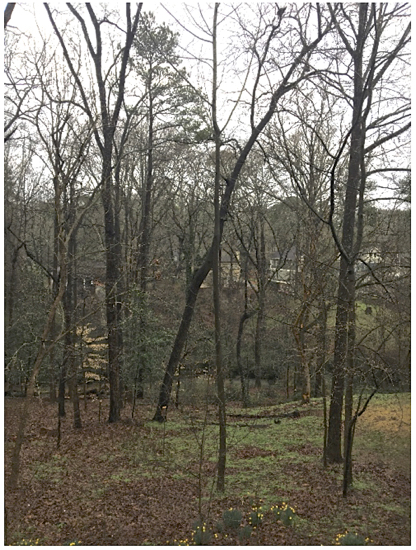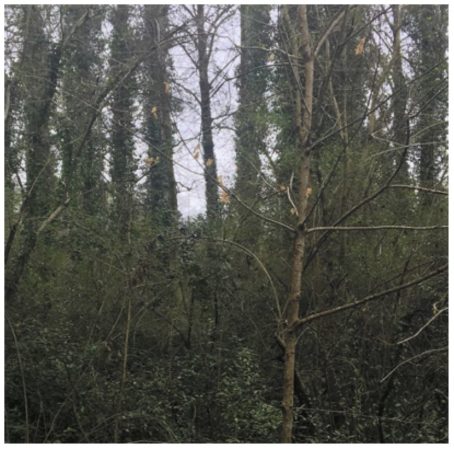The Story of My Backyard Woodland
February 19, 2020
Martha LaFollette Miller moved from Charlotte, NC to the Decatur area 7 years ago to be near her son and his family. In her former life she was a Spanish professor at UNC Charlotte for many years.
Here is the story of her backyard forest:
“When I moved from North Carolina to Midway Woods 7 years ago, I fell in love with the magnificent trees in my neighborhood and with the abundance of forested areas close by. I bought a house on a lot that slopes down to a branch of Shoal Creek. Falcon Murty, who designed and built my home, had understood the value of preserving the trees on the property and had incorporated woodland views into the floor plan. I loved my woods, but I had no idea at that time that my woods would come to occupy such an important place in my life, eventually becoming a full-fledged forest restoration project.
At first, the only issue I saw was English ivy on the ground and the tree trunks. Little by little, sometimes with help, often alone, I pulled the ivy out by hand, avoiding chemicals to protect wildlife. As I worked on my own property, and in Dearborn Park with neighbors, I became more and more familiar with the local landscape, and I gradually learned about the many other invasive plants that plague our woods. With the ivy under control, I turned my focus to Enemy No. 2, the Chinese privets that had become large enough to obstruct my view of the creek. I was still somewhat naïve, imagining that this unwanted plant would be my last major last challenge. A team of professional forest restorers led by Jeremy Dahl helped me dig, pull, and cut until the privet was mostly gone.
I now realize that in thinking that I had almost whipped my woods into shape in a mere four years or so, I had seriously underestimated the complexity of the task as well as my own deepening commitment to my woods. Many other invasives needed attention. I continued to work, and by now I have seen an awe-inspiring native landscape emerge from a tangle of exotic vines and imported shrubs of little value to the native ecosystem. I’ve freed majestic oaks, beeches, and hickories from the ivy that was harming them and created spaces where new native seedlings can thrive, including many new understory trees, such as redbuds.
I have also gained a historical perspective from a noted local naturalist, Kathryn Kolb, who estimated that many of my tall trees were a hundred or more years old and thus may have witnessed native Americans living along the creek and perhaps even heard Civil War cannons fired in the vicinity. Kathryn also identified some vegetation in the woods that grows only in undisturbed soil, indicating that my woods contained remnants of an old growth forest. I now dream of creating a small all-native forest refuge, where birds can find nourishment from plants that evolved along with them, instead of plants suited to animals in other parts of the world that can even be poisonous to our own bird species.
I still have a ways to go but a true native forest is now within reach!
Though small in size, the woodland I have nurtured has revealed to me what a healthy native forest looks like and the extent to which the surrounding woodlands are not healthy. All around the neighborhood I see forests that have been badly neglected. The natural areas of Dearborn Park are deteriorating before our eyes, as are the woods at Legacy Park. Everywhere, I see native trees being crowded out by privet, ivy, and many other invasives.
Wouldn’t it be wonderful if all the extraordinary woodland areas land along Shoal Creek could be brought back to health? We know what trees can do to combat climate change, especially mature woodland trees that are part of rich, complex ecosystems. The tangle of invasives strangling our woods is undermining the potential of our native plants, especially our mature native trees, to mitigate global warming and to nurture wildlife, such as the songbirds that are quickly disappearing.
As development threatens green spaces in Decatur, calls go out for tree plantings. From my perspective, vastly more effective would be preserving our existing trees and their habitats. In the woods, trees can live in a symbiotic relationship to each other. The existing soil has been enriched by decaying vegetable matter over centuries. The seedlings spring up in their natural habitat, but they can’t thrive if aggressive invasive plants take up their water, nutrients, and sunlight.

Here is a picture of my woods this February.

Here is a picture of unhealthy woods across the creek on the same day.
Can you help? I know that many residents of Decatur and the surrounding areas care about our green spaces and strongly favor their protection. A group of us from the area around Dearborn Park have formed the Dearborn Park Nature Alliance. We would like to hear from anyone who is interested in rescuing local woods from deterioration.
For more information about Dearborn Park Nature Alliance, contact:
Sarah Zingorelli sarahzingorelli@yahoo.com 404-373-7266
Martha Miller mlmiller@uncc.edu 404-377-0088
Great story Martha. It is amazing to see your dedication to maintain our woods on this area.
I would love to help. I’ve been dealing with ivy in my front yard. But the very worst invasive I’ve ever confronted is the non native wisteria in my backyard. I’ve dealt with kudzu and ivy without using chemicals just my hands and a shovel. But I’ve met my match with that #%€£ wisteria. And I see it every where around our area. I discovered Dearborn Park last summer looking for a place to take my dog where she could romp in the water and walk through the woods. It’s a wonderful place and I would be happy to help.
we’re doing the same in Ormewood park and trying to preserve native plants as much as possible while getting rid of ivy and privet. a long process for sure
Excellent what you have done. Keep up the good work and good example.